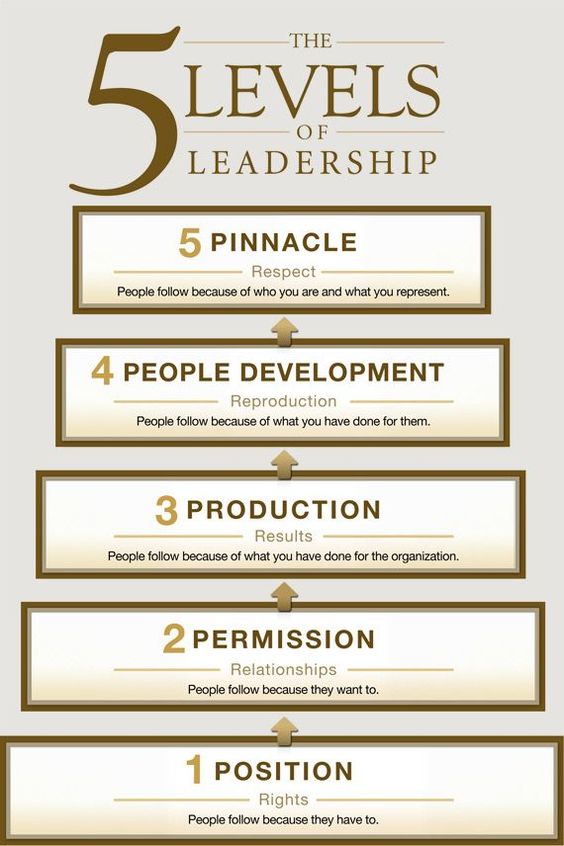Having a managerial title doesn’t make you a leader. It is, in fact, only the first step towards leadership. In The 5 Levels of Leadership, John C Maxwell points out the main pitfalls that often hold managers back from following the path to great leadership. At the same time, he also explains how we can overcome them.
A leader is made, not born. It takes perseverance, vision, strategy, and relationship-building skills, and many more qualities to merely work well in a managerial role.
To become a good leader, one has to practice and master each of these skills (levels) to become a truly well rounded, inspiring leader on their climb to the top.

Level 1: Defining Leadership Through Personality and Core Values
Reaching managerial positions is the starting point of the leadership journey. Many consider managerial positions an end-goal and become complacent once they reach them. Additionally, some managers think that positions give them the power to command.
Such leaders called Positional Leaders, and never really understand the true purpose of the position. They busy themselves with trying to gather a big team, most often unable to do much for the team as a leader. Positional leaders are so obsessed with their positions that they cannot give their teams direction.
Good leaders work towards creating a lasting impression on their subordinates. They need to choose their core values and principles based on who they truly are. Their core values should reflect in their personalities and in turn their leadership skills should be defined by their personalities.
Level 2: Building Trust and Positive Relationships
Leadership is always about what the manager can do for the team, and not about what he does for himself. Keeping this in mind, leaders should help create a work environment for the team that is conducive, fun, enjoyable, and most importantly comfortable.
Good leaders build positive relationships. To build these, leaders need to seek permission from their team members. In order to get permission, they need to foster positive relationships, gain trust, and value people around, and to do that, a leader has to think about others first.
For Example, the US Marines’ core value of not leaving anyone behind is clearly seen when he or she leaves his or her rank insignias behind before war. It helps level the relationships between ranks and created a feeling of camaraderie and belonging.
Level 3: Mastering How To Produce Result
Successful leaders are measured by the results they produce. A leader is able to generate successful results only with an effective team that helps him execute.
Therefore producing results often relates to how the leader chooses and manages the team, to steer it towards efficacy and success. Leaders need to understand that a good effective team not only comprises of individual performers but also of individuals committed to collectively succeeding in reaching the goal, by exercising their specific talents and skills.
The leader should know that the success of the team is a contribution of each individual as well as the success of an individual in the team is a collective effort of the entire team. Moreover, a good leader knows how to chart the team in the right direction. He, therefore, put efforts into building the team, in choosing the right person for the right role, according to their respective strengths and weaknesses.
Finally, the leader should also know how to optimize a team member’s performance in matters beyond the business as well.
Level 4: Creating A Wave Of Momentum By Leading With Example
George Washington, during the Revolutionary War, rode towards a group of soldiers who were unable to lift up a beam. Their commanding officer was standing beside them, shouting words of encouragement. However, the group was unable to lift the beam.
George Washington, dismounted, approached them, and helped to lift the beam. His physical contribution not only added the additional force that was needed to lift the beam, but his act of help instilled a sense of confidence and provided motivation to the soldiers. He displayed enthusiasm and drive that motivated the group to lift the beam. He also led by example and capitalized on his victory to build momentum.
In the words of Thomas Carlyle, “Nothing builds self-esteem and self-confidence like accomplishment.” A good leader knows that while inspiration to succeed is essential to success, capitalizing on that success to build a wave of momentum amongst the team is as important to uplift the team and generate even better results.

Level 5: Creating A Legacy By Helping Other Succeed
The final level of leadership is to be cognizant of two things –
- First, a truly great leader focuses on transforming the people around him for success.
- Second, a truly great leader builds a legacy by mentoring others to become great leaders.
Both these points work in tandem. A leader cannot build a legacy without helping others reach success, and similarly, he cannot help others reach their full potential without the knowledge and the empowerment of being able to mentor great leaders.
A leader knows that his people are his greatest assets in today’s dynamic work environment. Therefore, for the company to grow and succeed, or for the leader to grow and succeed, the focus of growth and success has to be on the workforce. People-development is one of the most crucial aspects of good leadership.
Yet a good leader knows where to pull back. He should be able to judge when to let the employee test the waters on his own. Empowering a team member to grow on his own is a mark of a truly transformative leader – a leader who puts 80% of his efforts in ensuring the productivity of their team.
This huge amount of effort that a leader invests in the employees pays back in the form of creating a legacy. No organization can survive with monopoly leadership. Leadership needs continuity for the organization to be consistent and successful. Therefore, great leaders invest much of their effort into ensuring that there is a culture of leadership in the organization that is as dynamic as the work culture today.
Leaders craft future leaders. And those leaders of the future carry the legacy of today’s leaders into infinity!
